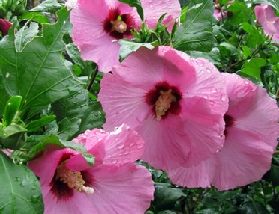Website and Images © 2014 Betty Mackey
Something Special in Garden Books






Spring Garden Tips


Pinching Back
Most annual flowers and some kinds of perennials and shrubs perform better if they are pinched back. Pinch or cut off the topmost growing tip to induce the plant to form side branches. Marigolds, zinnias, daisies, dahlias, cosmos, and chrysanthemums benefit from pinching. Surprisingly, foxgloves do too, and it is particularly effective if you pinch them back before the first stalk is in bloom. Side shoots appear to give you a cluster of flower stalks where otherwise there would be only one. But do not pinch back flowers that do not form branches. Daylilies and oriental poppies lose their blooms if you pinch them back. However, all garden flowers benefit from deadheading (removing the spent flower) unless you are trying to harvest the seeds.
Mulching with Cardboard
Make garden beds by mulching with cardboard. Build a barrier that kills grass and prevents weeds. Mark your areas and lightly clean them. Then cover them completely with a layer of flattened cardboard such as shipping cartons. Make sure to leave your perennials or shrubs uncovered but surrounded by cardboard. Then cover the cardboard with a layer of wood chips or other attractive mulch several inches thick. The cardboard breaks down into improved soil.
Make a Composter
You can make an inexpensive weatherproof composter in minutes by making a ring of chicken wire. Set it on top of the soil in a place that is easy to get to but hidden. I have several compost rings located in the back of the garden behind several thick rhododendrons.
1. Buy or find chicken wire (or other mesh) about 2 to 3 feet high and 12 to 15 feet long. It is available at hardware stores.
2. Take the roll of wire to the location. Connect the two ends by twisting pieces of the wire together. It may work best if you roll it in the opposite direction from the way it wants to go.
3. Start filling the mesh circle with sticks, leaves, kitchen waste, weeds, and such, using some as supports. You can even add some pine branches or cut ivy around the outside for camouflage. If you put in kitchen scraps such as lettuce leaves, orange peels, bean ends, and carrot peels, cover them up with a layer of brown leaves or garden trash to deter animal visitors. Do not add meat or bones to the pile, so as not to attract animals.
4. The smaller the bits, the sooner you get compost. But everything biodegradeable will work. Add about 3 parts of brown bits such as old leaves to 1 part of green or fresh vegetable matter such as grass clippings, for a good, fast compost.
5 After several months or more, when the compost is finished, unhook the ends of the chickenwire ring and remove it. Set it up in another place nearby and add any unfinished compost from the top of the pile. Then you have clear access to nice, brown compost which is ready to add to garden soil or potting mixtures.
8. Don't want to buy anything? Just make a circle of upright sticks or tree branches (set a few inches apart) to use as your composter. Hide it behind a bush or something because it looks messy. Thread vines or twine around to make a rough basketlike container out of them. Then pile the leaves and trimmings in for the compost. The organic material all degrades, including the sticks and vines used to form the composter. When it rots a lot, the black, finished compost is available underneath the brown topping of leaves and organic matter.

MOVE SNOWDROPS “IN THE GREEN”
As your snowdrops, species crocuses, anemones, winter aconites, and other small bulbs of spring start to multiply, you can dig them up and move them around, even if they are very small. Of course, you can do it after the foliage dries down, but will you remember what was blooming where, and what color it was? With minor bulbs, the roots may be reachable with a small shovel or even a trowel. Check carefully to make sure you get the whole plants. Then go ahead and dig some up and replant them where you want them to go. Next year they will pop up in their new locations.
